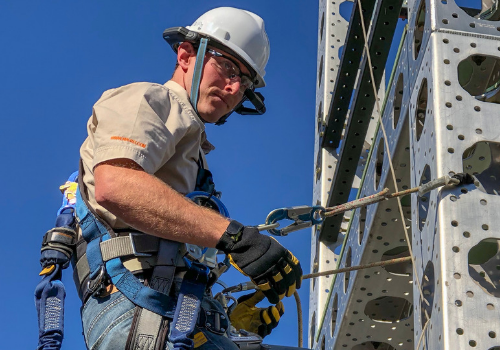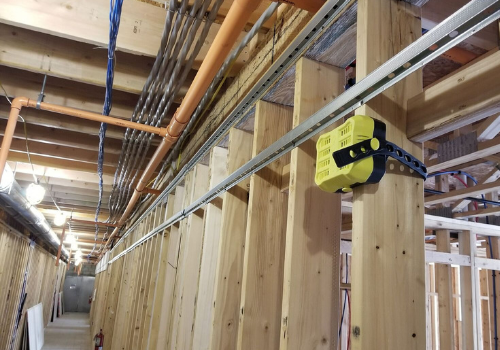With more than nearly 1,000 deaths and one in 10 construction workers injured in the U.S. each year, the construction industry has room for improvement when it comes to getting workers home safely. New technologies are emerging to make jobsites safer through earlier risk identification, predictive tools and augmenting human strength.
Learn what’s available and how you can benefit:
Jobsite cameras
Cameras are useful for more than marketing and jobsite progress reports. “Safety is one of the emerging use cases for cameras because of insurance interest and a general focus on safety,” says David Gaw, CEO of Sensera Systems. Sensera Systems’ solar-powered construction cameras can monitor sites 24/7, even if power and Internet are not available. When an incident or near miss occurs, video can help companies determine the root cause, take corrective action and develop specific training to prevent future accidents. Applications are growing. According to Gaw, a roofing contractor deployed Sensera cameras to remotely monitor critical operations for OSHA compliance and safety.
Sensera advises users on camera location, but installation of a camera takes less than 20 minutes and can be completed by the contractor. Cameras can easily be moved to different areas of the jobsite. Alerts can be sent when someone enters a restricted area. “That helps enforces the safety rules,” says Gaw. Sensera’s cloud platform allows viewing, monitoring and sharing jobsite images, video, and data. Integrations with programs such as Autodesk BIM 360, Procore, Plangrid simplify workflows.
 Wearables
Wearables
If you buy into the notion that hands-free operation of a mobile device is a safer than holding a phone or tablet in the field, you’ll be interested in RealWear HMT-1, a hands-free Android computer that attaches to a hardhat. The image on the screen is comparable to viewing on a 7-inch screen. Through voice commands, users can take jobsite photos, review plans and communicate while staying focused on the task at hand. “Unlike augmented reality devices like Microsoft HoloLens , our device focuses on the real world first, and supplements that with digital information,” says Co-founder and CEO Andy Lowery.
Information on the device could also provide users with step-by-step lockout/tagout instructions and create a digital record of the safety procedures. Remote assistance can provide mechanics and staff in the field with live support, data and images. According to Lowery, Bechtel and Skanska are using the devices and more than 10,000 units were sold in the company’s first year of production.
Mak-U-Safe is another wearable that holds promise for construction, although it will initially target manufacturing, animal processing facilities and logistics when it commercially launches in the fall. Workers wear an arm band that contains a number of sensors to measure temperature, sound, lighting, humidity, volatile organic compounds (VOCs) and carbon monoxide. An accelerometer measures the gravitational force of any motion over 2 g and classifies it as a slip, trip, fall or no-risk motion.
“By pressing a button, employees can talk into the device to report a safety problem and the location can be pinpointed,” says Gabe Glynn, CEO of Mak-U-Safe. Information is then automatically entered into an electronic report. Safety managers can identify when individual employees are at risk, but according to Glynn, the biggest benefit comes from mining the data to track trends and predict safety issues.
“Twelve people might trip over the same cord, and then person number 13 trips and falls. With the data collected and using our machine learning algorithm we can pick up on the leading indicators to prevent a fall,” says Glynn.
“Data is changing the conversation around safety,” says Glynn. “Employers understand they need to use the information as an opportunity for more relevant training, not for punitive measures.”
 IoT jobsite monitoring and predictive software
IoT jobsite monitoring and predictive software
An idea that was conceived in a dorm room at Wentworth Institute of Technology in Boston, Mass., is now keeping construction workers stay safe and protecting construction projects from damage. Sensor Pods from Pillar Technologies installed indoors in buildings under construction measure eight environmental metrics and provide an early warning system for fires, unsafe work conditions, mold growth and other environmental safety hazards. Batteries last up to one year and installation can be completed by the contractor.
Data is sent in real time to an online platform. The predictive capability of the software alerts managers when jobsite conditions indicate a high-accident probability. “We think of the construction site as having its own heartbeat, and we want to monitor it 24/7,” says Matt Joyal, co-founder and CTO.
Avalon Bay, a nationwide multifamily builder of wood frame apartments is using the Pods on 17 construction sites as part of a fire prevention program. Nabholtz Construction used the Pods to help ensure air quality for patients as well as workers during a hospital renovation.
“If contractors have experienced a risk management failure such as a fire, they understand how much money technology will save them in the long run,” says Joyal.
Exoskeletons take on heavy tasks
Sarcos Robotics’ Guardian™ XO® is a full-bodied, autonomously powered, exoskeleton designed to augment human workers and reduce injury. Back injuries account for almost 17 percent of nonfatal injuries resulting in days away from work in construction, but with the Guardian XO suit, a 20-pound item feels like one pound. Lift capacity is 200 pounds.
“The suit carries its own weight,” says Kristi Martindale, chief marketing officer for Sarcos Robotics. “It has a natural full range of motion.” When equipped with various end effectors, operators can perform highly precise tasks with heavy tools or components.
Martindale believes the Guardian XO exoskeleton will help extend the work life of people in construction and manufacturing jobs by reducing injury and fatigue.
Insurers have a growing interest in safety technologies as they look for ways to mitigate risk in construction. Ultimately it will be up to contractors to put these high-tech safety tools to the test. Because safety is such a huge factor in success, we think you’ll see more of these solutions soon.
Join over 32,000 industry peers who receive construction industry news and trends each week. Subscribe to CONEXPO-CON/AGG 365.












